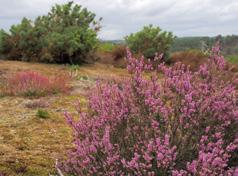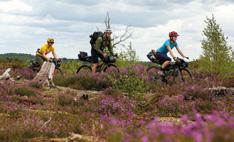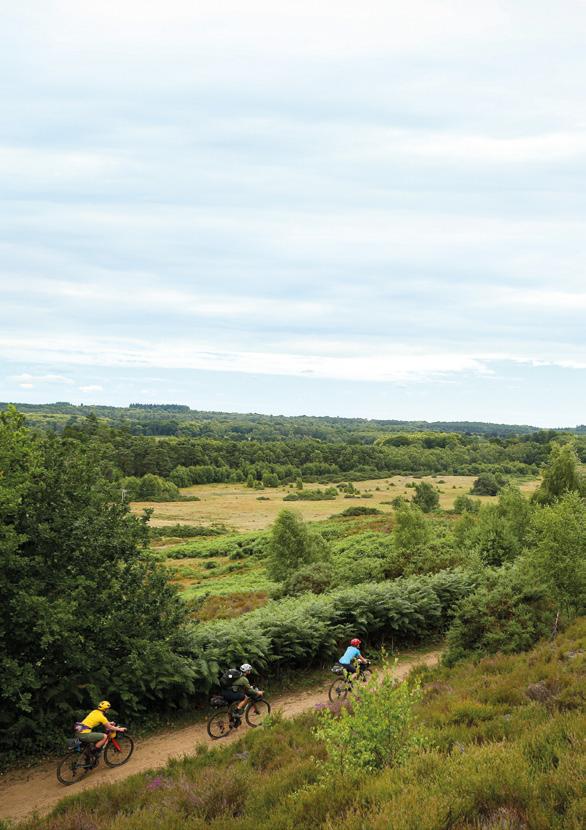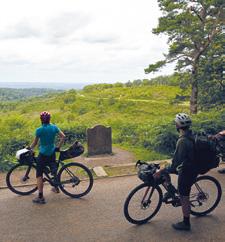
10 minute read
Part Seven – The Devil's Punch Bowl
The Devil’s Punch Bowl
PART SEVEN
Part 7 – The Devil's Punch Bowl
Farnham to Hindhead
Distance: 27km Ascent: 465m
Highlights
• Surprising solitude in a busy landscape. • Monastic history. • Wild heathlands and woods. • Mythical hot pot hot spots. • WWII secrets. • Legendary hell hounds, angry gods, highwaymen and buried roads.
Navigation
Again, our route designers have done an amazing job of threading through some major population centres while keeping things as tranquil and traffic-free as possible. That inevitably means a lot of twists and turns on sandy heathland trails where there are multiple options, along with many back road junctions and dodges too. On the plus side, the low levels of motor traffic at most junctions mean stopping to check the next step isn’t such an issue.
For busier built-up sections, a bit of pre-planning will make things a lot easier, though. Frensham and Thursley Commons are also worth taking steadily to stay on track, as there are numerous unsigned sidetracks, and it’ll help avoid running any of the rare wildlife over. The last run-in from Thursley to Hindhead is lovely and simple though, with the hill itself acting as unmissable point to aim for.
300m
200m
100m
0m 0km 10km 20km 27km
300m
200m
100m
0m
0km 10km

20km 32km
200m
100m
0m
0km 20km 40km 50km
Be aware
• Farnham is relatively busy compared to the rest of the route and things start to get hilly just to the south. It really ramps up at Frensham Ponds, where you start to get into the Surrey
Hills and soft sand under your tyres can really slow you down. • It’s also an area of dense population, so while the roads and tracks you’ll use minimise motor traffic, you’re likely to meet a lot of other trails users such as walkers, runners and horse riders, so always be ready to stop, be nice and say ‘hi’.
• The section over Hankley Common is military ‘managed access’ training land too, so watch out for camouflaged company and obviously heed signage at entry points.
• The climb up to the Devil’s Punchbowl/
Hindhead Common is a loose, rocky challenge and the top of the hill is busy with family visitors and other trail users, so be sensible with your speed however much you want a brew at the
National Trust café.

Area introduction and route summary
Our route planners are rightfully proud of the way this section joins the dots of history and beautiful heathland with a web of back roads and bridleways. The ducking and weaving through this busy area, plus a lot of soft sandy sections, means you’ll be working a bit harder up and over

increasingly significant hills. Technical trails mean you won’t necessarily be going fast on the descents either, but the effort is well worth it for the views and sense of space. From Farnham, you quickly vanish into forgotten lanes, popping up through a posh estate before dropping down to the UK’s first Cistercian monastery at Waverley Abbey. Then you’re switching from narrow lanes to woodland and heathland tracks through nature reserves, with an optional diversion to the gorgeous village of Tilford. The loop round Frensham and Hankley Commons can be bypassed if it’s too wet and slow going, but you’d be missing out on one of the highlights of the whole route in terms of wildlife and views. Once you’re through the pretty village of Thursley, it’s time to winch up the long, increasingly challenging climb to Hindhead Common. The views from the top and promise of coffee and cake are absolutely worth the effort though.
Farnham to Tilford Reeds
From Farnham Castle, you follow the open grassland of Farnham Park all the way along its perimeter on a permissive shared path before sneaking round the hospital, under the A31, past the popular Shepherd & Flock pub and then ducking along a well-surfaced bridleway. After little significant rise and fall for a long time, your legs will get a rude awakening as we divert left to climb through Moor Park estate, with its modern mansions hidden away in vast gardens on this most sought-after area. The original Moor Park House was where Charles Darwin wrote some of his revolutionary, evolutionary ‘Origin of Species’ book and Jonathan Swift – author of Gulliver’s Travels – was secretary to Sir William Temple who owned the house.
Unfortunately, the direct route here is recorded as footpath rather than bridleway, despite significant evidence suggesting it is in fact an old carriage road – but when the manor house was sold by the council some decades ago, they didn’t secure the access rights. An application for upgrade has recently been submitted, which, if successful, should allow the route to access this old carriage drive and pass by ‘Mother Ludlam’s Cave’ with its natural spring, stream and a rich place in local folklore.
Your reward for the climb up is a good run down Camp Hill where you can cross the river to visit the remains of the original English Cistercian settlement at Waverley Abbey (also featured in the film ‘28 Days Later’), or turn sharp left onto more wooded gravel track through Sheephatch Copse.
It’s a bit of a squeeze over Tilford Mill Bridge and along the narrow hedge-lined lane, then you’re off-road again through the woodland and gravel paths of Farnham Heath Nature Reserve. If you’re thirsty or just want to see a particularly pretty English village,

Waverley Abbey
Sitting quietly on the banks of the River Wey, the remaining 13th-century vaulted dining hall and other buildings are now an oasis of calm and contemplation. The arrival of twelve Cistercian monks and an Abbot in 1128 marked a massive moment in the creation of the monastic church revolution across Britain. The Abbey continued to be an increasingly important centre for the wool trade, pilgrims, travellers and an infirmary for the sick until Henry VIII set up the Church of England and dissolved and demolished many monasteries, including Waverley.

the kilometre detour to Tilford is well worth the short time it takes. With its village-green cricket pitch, ancient oak tree, old inn, half-timbered buildings and narrow bridge over the shallow River Wey, it’s a tick box of yeomanry quaintness, and there’s a well-stocked village shop too.
Tilford Reeds to Frensham Common

Back on track, you’re following the direction of the River Wey through Tankersford Common and you’ll curve round past Pierrepont Home Farm with its artisan cheesemakers to cross the river at the wooden footbridge. The bridge was being re-decked when we rode the route in July 2020, so paddle-phobes should detour through Millbridge, but if you don’t mind wet feet we can happily report the ford is only axle deep in summer, though rocky enough to make riding across awkward. Whether your feet are dripping or dry, the breathtaking landscape and views of Frensham Common will soon grab all your attention.
Frensham Common
The large ponds and ridgeline views of Frensham Common have been a focus for the local population for thousands of years, as the alignment of barrows still visible today shows. In fact, the archaeological record stretches right back to Mesolithic pit dwellings dated to around 6000 BC, as well as Neolithic stone axe heads and hundreds of Bronze Age arrowheads. Further settlement evidence exists for the Iron Age and post-Roman period too, with the Saxons defeating a Viking raiding party here in 893 AD. Local folklore also talks of a great stone on the ridge which may have been a monolith or remains of a barrow. Knocking on that stone would allow you to borrow whatever you wished for a year, after which it must be returned. Unfortunately, the charm was broken when a giant cauldron was borrowed but not returned on time and left in the vestry of Frensham church. Interestingly, there’s another cauldron story relating to Mother Ludlam’s Cave where the giant pot ends up at Tilford church after being borrowed from a monk, but whether it’s the same cauldron or the area was some kind of mythical hot pot hot spot is unclear.

Neither Frensham nor Tilford churches have a cauldron anymore, and there’s no trace of the stone either, so you’re out of luck if you need to borrow a GPS, map or compass for the rather complicated dance the route takes for the next few kilometres. The tracks around Kettlebury Hill and Thursley Common are a lovely place to get lost in your thoughts anyway. A timeless oasis South of Thursley, the rolling Surrey Hills definitely pick up pitch towards Beacon Hill and, as narrow tarmac lane gives way to rough track, you’ll be dropping gears as quickly as you drop speed. Take your time, though, as the beautiful tree-lined track up onto the top of Hindhead Commons is to be savoured not suffered. of heathland, sandy tracks, bogs and ponds where lizards and dragonfly flourish and even ospreys visit occasionally. Steep hills and deep sand are a challenge in the dry so, if the going is getting wet and heavy, it’s worth knowing that both these heathland adventures can be bypassed easily on relatively quiet roads too, but we definitely
Frensham Common to Hindhead
recommend visiting at least one if you can. With epic views from the skyscrapers of distant London right over the rest of southern England, the Devil’s Punch Bowl is an area soaked in history of all ages too. It’s certainly a fantastic place to stop and catch your breath while having a bit of an explore before dropping down into Hindhead, where this section ends. It’s worth popping to the trigpoint at Gibbet Hill too for some more spectacular views.

Hankley Common Atlantic Wall

Pretty much every wood or piece of common in this area has some sort of concrete relics from WWII, but Hankley Common was a particularly interesting top-secret site. The main feature is a 100m long, reinforced concrete replica of the German ‘Atlantic Wall’ defences from Normandy. This was built by Canadian engineers in 1943 for the testing of explosives and assault techniques, but the area was also used to develop the specially modified ditch-crossing, flamethrowing, mine-clearing and demolition ‘Funny’ tanks of the 79th Armoured Division. In recent years, it has been used as a landing area for paratrooper training, and it also remarkably doubled for the Scottish Highlands during the filming of the James Bond film ‘Skyfall’.


The Devil’s Punch Bowl
Even the name is steeped in legend – supposedly, the Devil would torment Thor, the God of Thunder, by jumping from hill to hill while Thor tried to strike him with his lightning bolt (there’s even a place called ‘The Devil’s Jumps’ near Frensham Common), until one day the Devil scooped up a fistful of earth and hurled it at Thor, creating the punch bowl shape. It was one of the first areas bought up for preservation by the National Trust in 1906. Hindhead Common – not Dartmoor – was apparently the original inspiration for the setting of Conan Doyle’s Sherlock Holmes story ‘The Hound of the Baskervilles’, but most of the dogs we met on our recce were friendly enough. The wildness of the Common and its position on the London to Portsmouth road made it a notorious haunt of highwaymen and Gibbet Hill marks the spot where three men were hung for the murder of a sailor in the area. You won’t find a gibbet there anymore as it was replaced by a replica Celtic cross by politician and lawyer Sir William Erle in 1851.
More recently, the whole hill was tunnelled in 2011 to hide the A3 underneath, restoring the sense of natural tranquility you can experience now.










